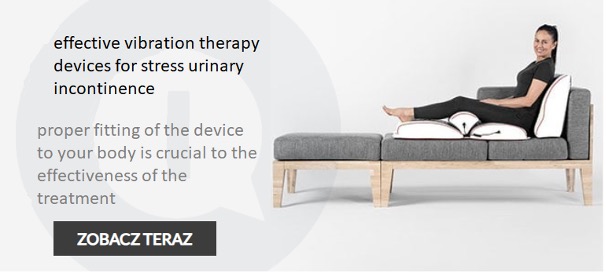Stress Urinary Incontinence is a consequence of pelvic floor muscle weakness that can be minimised. The treatment process, although often long, arduous and embarrassing for most patients, can be further assisted at home in a way that does not require significant effort on the part of the patient or any discomfort from the treatment.
Polish discovery
According to researchers from the Medical University of Katowice, the muscle response to vibration is reflex in nature, referred to in the literature as the Tonic Vibration Reflex (TVR). When the muscle-tendon complex is mechanically stretched, there is an activation of the ring and spiral endings of myelinated Ia fibres, which then stimulate the ‘α’ motoneurons and consequently the muscle contracts (Kwaśna et al. 2012). In 2005, Dr Issurin, in his study, demonstrated that mechanical vibrations can induce will-independent muscle contractions – even muscles unable to respond to electrical stimuli. This effect was originally attributed to a potential ‘increase in nerve cell activity at the site to which such vibrations were applied’.
Stimulate muscles to work
This phenomenon, generated by vibration, seems to play an essential role in the treatment of a disturbed urethral closure mechanism. In both types of UVC (excessive bladder and urethral mobility and weakness of the urethral sphincter muscle), an unsatisfactory muscular ability to contract is to blame. Vibration stimulates a specific muscle group to work (in fact, with the apparent immobility of the patient, i.e. no effort on his part, vibration engages more than 90% of the muscle fibres !!!). The tonic vibration reflex induced by them is active throughout the vibration stimulation, i.e. the duration of the treatment. Cyclic contractions and relaxations of the muscles occur until the stimulus stops. Thus, vibrotherapy can be considered an effective, excellent exercise technique in the treatment of such an unpleasant phenomenon as Stress Urinary Incontinence, particularly valuable for people who are immobile or limited in their ability to perform active physical exercises.
Vibration and stress urinary incontinence
Dr von der Heide, together with Dr Emons Gunter, demonstrated that muscle stimulation through vibration training improves the subjective and objective parameters of stress urinary incontinence (Heide et al. 2003). Vibration rehabilitation is a promising, non-invasive and well-tolerated adjunctive method for the treatment of WNTM, and does not have as significant contraindications as other therapies treating this condition.
In addition, Kosar and Ozturk in their study ‘Effect of vibration-therapeutic massage on patients after extracorporeal lithotripsy, with renal calyx stones’ demonstrated that vibration massage after extracorporeal lithotripsy aids the passage of deposit fragments in patients with renal calyx stones, facilitating rehabilitation.
Vitberg’s research confirms that vibration therapy can significantly reduce existing urinary problems after just two days.
 Results from the Vitberg internal study. The data illustrate the percentage of subjects who noticed a reduction in symptoms, related to stress urinary incontinence, on a given day.
Results from the Vitberg internal study. The data illustrate the percentage of subjects who noticed a reduction in symptoms, related to stress urinary incontinence, on a given day.
More than half of people cured
Researchers from the University of Copenhagen, after numerous studies, conducted an experiment using vibration therapy. The results were surprising. Among 33 women, 29 suffered from stress urinary incontinence. Of these, 24 were cured and five showed an improvement in their incontinence symptoms as a result of six treatments of vibration stimulation of the perineal nerves, performed once a week.

In 2015, researchers from Tehran University of Medical Sciences showed that vibration therapy, carried out in a sitting position, was an effective rehabilitation tool in increasing pelvic floor muscle strength – a similar effect was obtained after pelvic floor muscle exercises. Results were also seen in a reduction in urinary aggravation and an increase in the I-QOL (quality of life with stress urinary incontinence) questionnaire score. (Farzinmehr; Moezy; Koohpayehzadeh; Kashanian: #319 A comparative study of Whole Body Vibration Training and Pelvic Floor Muscle training on women’s stress urinary incontinence: Three-month follow up. w: Journal of Family and Reproductive Health).
A.M. Borowicz, in “Physiotherapy methods in urinary incontinence therapy”, notes that type I muscle fibres respond to stimulation in the frequency range 10-25 Hz, while type II muscle fibres respond best to a frequency of 35-50 Hz. Muscle strengthening is achieved by using frequencies affecting type II fibres, which is particularly beneficial in Stress Urinary Incontinence (Gerontol. Pol. 2010; 18, 3: 114-119).
Complied from:
- Farzinmehr; Moezy; Koohpayehzadeh; Kashanian: #319 A comparative study of Whole Body Vibration Training and Pelvic Floor Muscle training on women’s stress urinary incontinence: Three-month follow up. w: Journal of Family and Reproductive Health.
- Sønksen; Ohl; Bonde; Læssøe; McGuire: #40Transcutaneous Mechanical Nerve StimulationUsing Perineal Vibration: A Novel Method forthe Treatment of Female Stress Urinary Incontinence. w: THE JOURNAL OF UROLOGY
- Koşar, Oztürk, Effect of vibration massage therapy after extracorporeal shockwave lithotripsy in patients with lower caliceal stones, J Endourol. 1999.
- Heide, Emons, Hilgers i Viereck (red.): #36 On muscles of mechanical vibrations produced by the Galileo 2000 in combination with physical therapy in treating female stress urinary incontinence. International Continence Society 33rd Annual Meeting. Germany.
- Adrianna Maria Borowicz 1, 2, Katarzyna Wieczorowska-Tobis1 1Katedra i Zakład Patofizjologii, Zakład Geriatrii i Gerontologii Uniwersytetu Medycznego im. Karola Marcinkowskiego w Poznaniu 2 Samodzielny Publiczny Zakład Opieki Zdrowotnej im. Roberta Kocha w Wolsztynie “Metody fizjoterapeutyczne w leczeniu nietrzymania moczu” / Physiotherapy treatment in urinary incontinence




